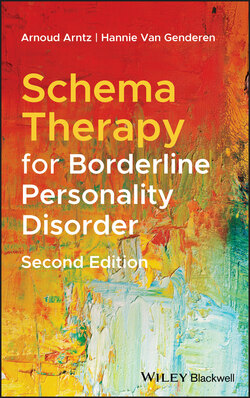Читать книгу Schema Therapy for Borderline Personality Disorder - Hannie van Genderen - Страница 35
3 Treatment
ОглавлениеThe process of change in ST for BPD takes place along three distinct channels: feeling, thinking, and doing. These channels correspond to the three levels of knowledge representation that are present in the schemas: explicit knowledge (thinking), implicit “felt” knowledge (including emotional representations or feeling) and operational representations (doing).
In addition to these three channels, we can also distinguish four different foci, which can be addressed by these channels. These foci are life outside of therapy, experiences in therapy, past experiences, and future life. The channels and foci are presented in a matrix in Table 3.1 so that it is clear which relevant therapeutic techniques can be best applied for the different foci.
Whatever topic the patient focuses on and whatever pathway is tried, these techniques can only be successful once a certain level of trust and attachment to the therapist is formed (see “within therapy” in Table 3.1). Because of the importance of the relationship between patient and therapist, we will address the specifics of the therapeutic relationship in ST in Chapter 4 immediately after discussing treatment in this chapter. After the therapeutic relationship is addressed, we will move on to the techniques. First, we will discuss the change of implicit knowledge in Chapter 5 (Experiential Techniques), then thinking or explicit knowledge in Chapter 6 (Cognitive Techniques), and finally “doing” or changing operational representation in Chapter 7 (Behavioral Techniques). All of the subjects summarized in the matrix (Table 3.1) can be found in the following chapters. However, first we will examine the phases involved in the course of treating BPD with ST.
Table 3.1 Therapeutic techniques
| Focus | Channel | ||
|---|---|---|---|
| Feeling | Thinking | Doing | |
| Outside therapy | * Role‐play present situations* Imagining present situations* Practice feeling emotions* Exposure to showing emotions | * Socratic questioning* Formulating new healthy schemas and strengthening the Healthy Adult Mode* Schema dialogue* Flashcards* Positive logbook* Self‐monitoring Circle | * Behavioral experiments* Role playing skills* Problem solving* Trying out new behavior |
| Within therapy | * Limited reparenting* Empathic confrontation* Setting limits* Role switching therapist/patient | * Recognizing patient's schemas and modes in the therapeutic relationship* Pro's and con's Coping Modes* Challenging ideas about therapist* Self‐disclosure | * Behavioral experiments* Strengthening functional behavior* Training skills related to the therapeutic relationship* Modeling by therapist |
| Past | * Imagery rescripting* Role‐play past* Two‐or‐more‐ chair technique* Writing letters | * Reinterpretation of past events and integration into new schemas* Historical test | * Testing of new behaviors on key individuals from the past |
| Future | * Imagery or role‐play about situations in the near future* Two chair technique: dialogue between dysfunctional (old) modes and the Healthy Adult | * Developing new goals for the future, based on own needs, interests and talents* Anticipate on activation of schemas in difficult situations* Choose which situations, activities and people to engage in, and which not | * Testing of new behaviors on new contacts* Making new friends* Explore and try out new activities (e.g., education or work) |
Most of the techniques are also demonstrated in a recent audiovisual production Schema Therapy Step by Step, van der Wijngaart and van Genderen (2018). The purpose of this production is to familiarize therapists with all aspects of ST. When applicable, we will refer to relevant scenes.
